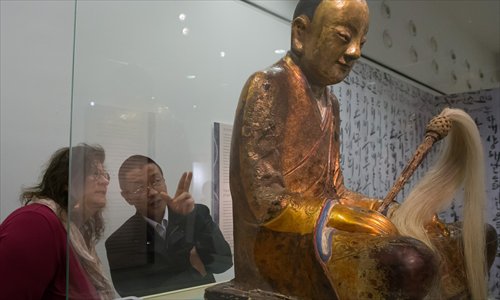Mummy dearest
Source:Xinhua Published: 2015-12-10 22:23:01
Collector, authorities argue over where repatriated relic should go

A Chinese mummy Buddha statue is admired by visitors to the Hungarian Natural History Museum in Budapest, Hungary on March 3, 2015. The statue, which conceals the mummified remains of an ancient monk, was withdrawn from the museum by its Dutch owner. Villagers living in Yangchun, a village in East China's Fujian Province, claim that this statue is the one stolen from their village's temple in 1995, Chinese media reported. Photo: Xinhua/Attila Volgyi
The disputed 1000-year-old Chinese mummy Buddha was thrown into the spotlight once again last week as the villagers of Yangchun, a small village in East China's Fujian Province initiated a legal procedure to have the statue returned to the Puzhao Temple, while the Dutch collector insists on giving it to a bigger temple, but only if his conditions for repatriation are satisfied.
The collector's three conditions for the repatriation of the statue raised serious questions about his sincerity, and all but the condition on research cooperation have been rejected by Chinese authorities, Xinhua learned.
"Firstly, I want it to go to a big temple instead of the small village temple. Secondly, I want to do some scientific research, for which I hope to get some cooperation, and although I finally got a confirmation [from the Chinese authorities], any follow-up failed," the collector told Xinhua in an interview, after Yangchun villagers initiated legal procedures in mid-November to reclaim the statue which they refer to as the Zhanggong Patriarch.
"Thirdly, I just want them to pay a reasonable amount of money, as is normal. But they are not planning to do so either," said the Dutchman.
Xinhua learned from various sources that the Dutch collector, who acknowledges that the statue should go back to Fujian Province, hopes to return it to the South Putuo Temple on Fujian's Xiamen Island.
Hovering above the sea, South Putuo Temple is one of the most famous temples in China. The Puzhao Temple in Yangchun village, where there are only 1,800 residents, is small and has recently been renovated.
"South Putuo Temple has told us that since it came into being, it has never worshiped any mummy Buddha and it has no intention to enshrine and worship the Zhanggong Patriarch now. We have transferred their letter to the Dutch collector," a Chinese State Administration of Cultural Heritage (SACH) official told Xinhua.
Rival evidence
"I can scientifically prove that the statue does not come from that village," the Dutch collector told Xinhua over the phone. His view stands in direct opposition to the SACH declaration that the statue had been stolen from Yangchun village 20 years earlier.
"Reports said villagers remember a hole drilled in the left hand of the Buddha, and that the head was lost. With my hand on my heart I tell you, there is no hole in that hand, and his head is not lost at all," said the collector, who still wishes to stay anonymous though his identity has been disclosed by other media.
"Just with these two points, I can prove it is not their mummy. They can see the MRI scans of the statue. If they still do not believe it, they can make their own scans," he said.
It was through scans that researchers commissioned by the Dutch collector found out that a mummified body is encased in the statue.
When the statue toured in a mummy exhibition in Hungary in March 2015, overseas Chinese residents there noticed its resemblance to the missing Zhanggong Patriarch in their home village and took on a cross-continental quest for its return.
For Chinese cultural heritage researchers, details such as a hole in a hand or a crack in the neck are excerpts from the memory of just a few villagers.
"These details cannot be counted as hard arguments, especially when there is a full package of really crucial evidence," a SACH official told Xinhua.
Photos taken by villagers in the 1980s show a cross-legged seated Buddha figure with a faint smile and shoulders slightly hunched forward.
An obvious difference between the figure in the photos and the statue in the exhibition is that the statue in the photos wears clothes, which makes the Dutchman doubt the authenticity of the villagers' Buddhist faith.
"If someone really took away the statue, why would they have taken its clothes off? That he would ever have worn clothes is ridiculous. A real Buddhist monastery would not put clothes on such a statue. It is completely decorated with decorations of symbolic and religious value, you would not hide those under clothing," the collector argued in a conversation with Xinhua earlier in May.
A copy of an SACH document obtained by Xinhua explains that the Buddhist beliefs in southern Fujian have adopted local forms, blending Buddhism, Taoism, witchcraft and folk customs. In its particular traditions, patriarch statues are always crowned and dressed.
No other institution or individual in Fujian has made any claim to ownership of the Buddha since it gained international attention.